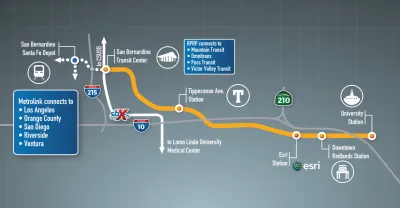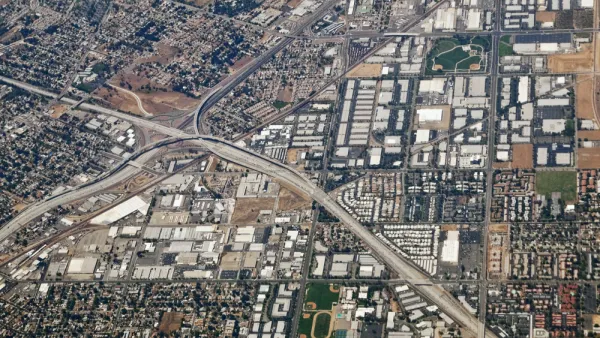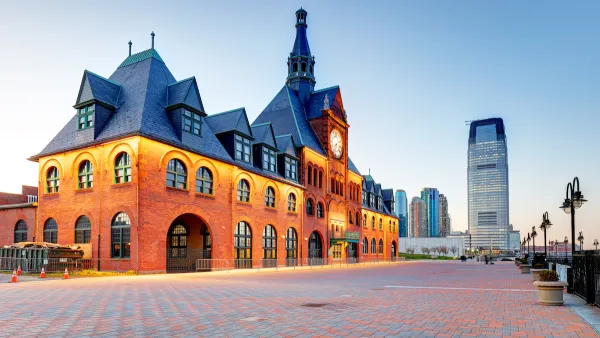The nation's first fuel cell electric train will make its debut in Southern California in about four years, but it's also associated with a controversial ballot measure on the station sites that voters of Redlands will decide on Super Tuesday.

Train service is scheduled to begin in about two years between Redlands and San Bernardino in the region known as the Inland Empire between Los Angeles County and Arizona and Nevada.
Initially, passengers will board diesel multiple units (DMUs) for the nine-mile trip between the two cities in San Bernardino County, but in 2024 the line will operate the continent's first fuel cell electric trains, known as zero-emission multiple units, or ZEMUs. No doubt they will make a sensation as state officials will likely showcase the cutting-edge technology to reduce greenhouse gases in the most-difficult-to-reduce sector, transportation.
However, a strategy that has the potential to greatly further reduce emissions associated with the corridor will be up to the voters of Redlands, a slow-growth city of just over 71,000 people, who will decide on March 3 whether to approve or reject Measure G which would amend the general plan and loosen the city's three slow-growth measures so as to allow for development of transit villages around the three station sites.
NPR aired a 3-minute story about the ballot measure associated with the new train service last Sunday (Feb. 14) on "All Things Considered." Benjamin Purper of KVCR, an NPR-affiliate based in San Bernardino, narrated and wrote the article.
"The core intention of transit-oriented development is to reduce the carbon footprint," says Mayor Paul Foster. "It's to get people out of their vehicles and to walk."
"I think that it will really change Redlands forever. And we'll never be able to get it back," says resident Lane Schneider [and treasurer and principal officer of “Save Redlands — No on G."]
Purper wrote and spoke at greater length on the ballot measure for KVCR on Feb. 18 (listen to his 14-minute report – source article).
Measure G would remove the 400 homes a year restriction from the old slow-growth measures [see impartial analysis [pdf] of the measure].
[Measures U and N and Proposition R] passed in the 70’s, 80’s, and 90’s, limited height and density of residential buildings in an effort to preserve Redlands’ small-town feel.
Purper does an excellent job of getting views from voters on the Yes and No on G campaigns, and from planning academicians as well.
Seva Rodnyansky, a professor of urban and environmental policy at Occidental College, says that transit-oriented development, like what Measure G is proposing to do around the transit villages, does get people out of their cars to some extent.
“I would say that households living near, or in transit-oriented developments, generally speaking, drive quite a bit less at each income swath, you know, anywhere from 10-15 miles less per day, overall, averaged out based on travel survey data per day and that'll translate to a certain amount of greenhouse gas emissions that they're just not producing," Rodnyansky says.
Genevieve Giuliano, a professor of urban planning at the University of Southern California, is a little more skeptical. She says the evidence that transit-oriented development gets people out of their cars is mixed.
“And the reason it's mixed is that a transit-oriented development in Washington, D.C. is something very different from a transit-oriented development in Redlands," Giuliano says.
There's a broader theme playing out in Redlands that should concern all those who want to see greenhouse gas emissions reduced from transportation – there's technology, like electrification (which includes vehicles powered by fuel cells as well as batteries), and then there are the more complex issues surrounding the land use at the train stations that reduce driving, a major reason why these emissions have been increasing in the last five years in California. It may very well prove easier to make progress in the former if voters rebel at the notion of increasing residential density.
Look for the election outcome after March 3 in the comment section below.
Related in Planetizen:
-
Train Buffs: Do You Know What a ZEMU Is? May 1, 2018
FULL STORY: With Measure G, Redlands Joins The Debate Over Housing And Transit-Oriented Development

Analysis: Cybertruck Fatality Rate Far Exceeds That of Ford Pinto
The Tesla Cybertruck was recalled seven times last year.

National Parks Layoffs Will Cause Communities to Lose Billions
Thousands of essential park workers were laid off this week, just before the busy spring break season.

Retro-silient?: America’s First “Eco-burb,” The Woodlands Turns 50
A master-planned community north of Houston offers lessons on green infrastructure and resilient design, but falls short of its founder’s lofty affordability and walkability goals.

Test News Post 1
This is a summary

Analysis: Cybertruck Fatality Rate Far Exceeds That of Ford Pinto
The Tesla Cybertruck was recalled seven times last year.

Test News Headline 46
Test for the image on the front page.
Urban Design for Planners 1: Software Tools
This six-course series explores essential urban design concepts using open source software and equips planners with the tools they need to participate fully in the urban design process.
Planning for Universal Design
Learn the tools for implementing Universal Design in planning regulations.
EMC Planning Group, Inc.
Planetizen
Planetizen
Mpact (formerly Rail~Volution)
Great Falls Development Authority, Inc.
HUDs Office of Policy Development and Research
NYU Wagner Graduate School of Public Service



























